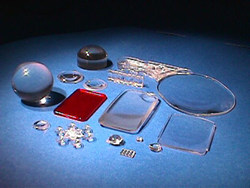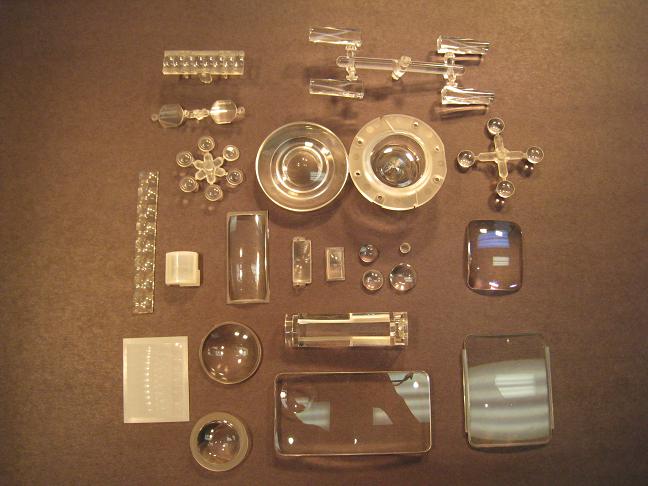The advantages of using Plastic Lenses compare to traditional glass lenses include lower cost (if produced at high volume), less design constraints and ease for manufacturing. Some disadvantages are limited usage at high temperatures, higher birefringence potential, limited refractive index range and looser tolerances. Below is a table of selected Plastic Lens materials and their properties, from the May 2000 issue of Photonics Spectra*.


| PROPERTIES | UNITS | Acrylic, Polymethyl Methacrylate | Polystyrene | Styrene Methyl-methacrylate Copolymer | Styrene Acrylonitrile | PolyCarbonate | Cyclic Olefin Copolymer |
| Refractive Index (Nd) | - | 1.491 | 1.59 | 1.56 | 1.57 | 1.584 | 1.525 |
| Abbe Value (Vd) | - | 61.4 | 31.1 | 35 | 37.8 | 34.5 | 56 |
| dn/dt | x 10E-5/ °C | -12.5 | -12 | -14 | -14 | -14.3 | -10 |
| Luminous Transmittance | %Transmittance @ 3mm | 92 | 88 | 90 | 88 | 90 | 92 |
| Birefringence Potential | Qualitative | Low | High | High | High | High | Low |
| Relative Haze | % | 2 | 3 | 3 | 3 | 3 | 2 |
| Coefficient of Linear Expansion | cm/cm x 10E-5/°C | 6 | 6 | 6.8 | 6.8 | 6.9 | 6 |
| Deflection of Temperature (3.6 °F/min @ 66 psi) | °C | 101 | 110 | 100 | 100 | 146 | 147 |
| Water Absorption (immersed 24 hr. @ 23 °C) | % | 0.3 | 0.2 | 0.15 | 0.3 | 0.15 | 0.01 |
| Hardness (Scratch Resistance) | Rockwell M | 90 | 90 | 80 | 75 | 50 | 75 |
| Izod Impact Resistance | ASTM D256 | 0.35 | 0.35 | 0.5 | 0.45 | 2 | 0.32 |
Values stated are typical. Contact the manufacturer for actual values for a specific material. * Bulter, David J. (2000) "Plastic optics challenge glass," Photonics Spectra May, 2000, p.168-174.
Aspherics Ball Lens Binoculars CCD Corner Cube Lens Cylindrical Lens Fresnel Lens Lens Assembly Micro Lens Optical Filter Plastic Lens Prism Reflector Rod Lens Special Lens
Home Optics Lasers Electronics NightStar Contact us
copyright ©
A.W.I. Industries (USA) Inc
Version 3.7
Designed by BCY


